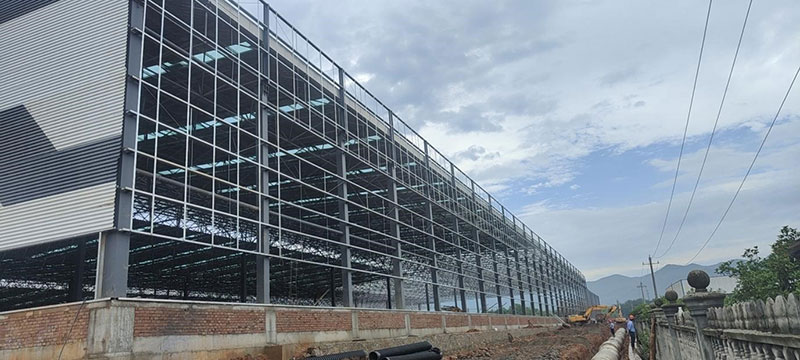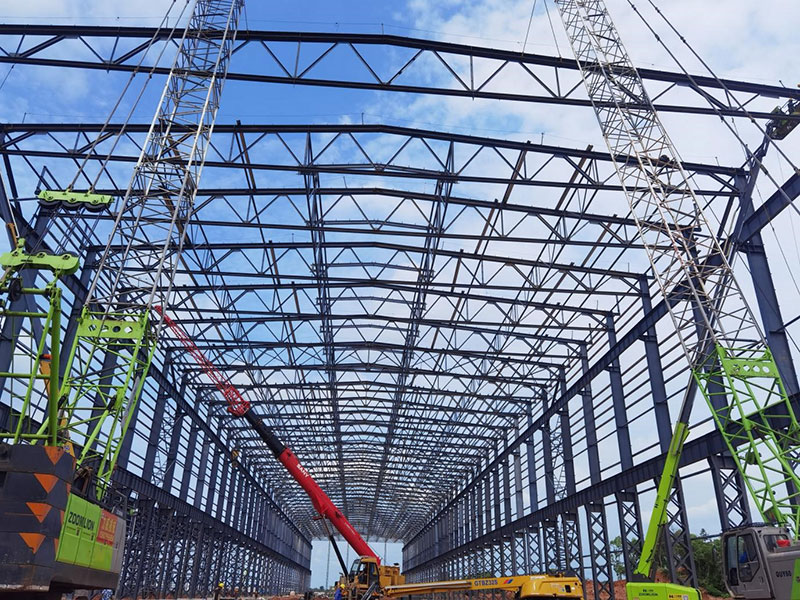Prefabricated factory buildings adopt an “off-site fabrication, on-site assembly” approach, significantly improving construction efficiency and quality. Through standardized production and modular design, they reduce project timelines, save labor costs, and enhance component precision and control. Additionally, prefabricated components are reusable, making construction more sustainable while offering excellent scalability and flexibility. Compared to traditional methods, prefabrication provides greater advantages in cost control, quality assurance, and sustainability, making it the preferred choice for modern factories, logistics centers, and similar projects.
Improved efficiency
Prefabricated factory buildings demonstrate outstanding performance in construction efficiency enhancement. Specifically, critical structural components such as steel beams and columns are manufactured in factories according to design specifications before being transported to the construction site for precision assembly. Compared to traditional cast-in-place construction methods, this prefabricated approach significantly reduces on-site wet work and temporary facility requirements by shifting the main production processes to controlled factory environments. Moreover, the method exhibits remarkable weather resistance. As most fabrication processes are conducted indoors, they remain largely unaffected by extreme weather conditions. This characteristic substantially improves schedule predictability and provides more reliable guarantees for on-time project delivery.
At present, prefabrication is gradually becoming the mainstream practice in many industries. According to statistics, the overall construction period of projects using prefabricated construction can be shortened by about 30% to 50%, and the on-site labor force can be reduced by more than 40%. With the improvement of standardization and modularization, prefabricated construction methods have been widely used in steel structure workshops, logistics warehouses, and other fields, especially for projects with limited urban space or a tight construction period.
Take the Dalian Insulator Production Workshop Prefabrication Factory Construction Project, with a total area of 150,000 square meters that we undertook as an example. If the traditional construction method is used, it usually requires 400 workers, and the construction period exceeds one year. However, with the prefabricated construction plan, only about 150 workers are needed, and the main structure can be completed within 6 months. It not only saves labor input but also reduces the collaboration and management costs during the construction process, and the overall construction cost can be saved by about 30%. This method not only ensures the construction quality but also shortens the production cycle for the enterprise and improves the overall benefits of the project.

Quality Assurance
According to the data of some typical projects, after using the prefabrication process, the processing accuracy of the components is significantly improved, and the error of the structural strength can generally be controlled at about ±3%, while the common error under the traditional method is often ±10%. While improving efficiency, automatic cutting and mechanical welding also control the construction errors of key parts such as nodes at the millimeter level, the quality of the welds is stable, and the qualified rate is significantly improved. With the popularization of digital design tools, such as the application of BIM collaborative modeling and automated cutting technologies, many large industrial plants and high-standard scientific research buildings have begun to prefer prefabricated construction to meet higher requirements for structural performance and delivery quality.
Taking a newly built steel structure factory project as an example, the project team used CNC equipment to uniformly cut the main beams and column bases, and then completed the assembly through the automatic welding process in the factory, reducing human errors. All connecting plates are drilled and assembled before leaving the factory, and almost no changes are required after arriving at the site. Composite panels with good compressive properties are used for the roof and wall enclosures, which not only enhance the overall wind resistance of the structure but also reduce maintenance costs. From the deepening of the drawings to the on-site assembly, each link is connected in series through standardization, which ultimately improves the stability of the overall structure and reduces the uncertainty of the construction period.
Cost Control
In factory construction, prefabrication technology has outstanding performance in cost control. Core components such as steel beams, floor slabs, columns, etc., are uniformly manufactured by the factory. Centralized procurement reduces the unit material price and reduces the loss caused by manual errors. Unified processing improves the yield rate of components, and large-scale cutting or welding is no longer required on-site. The labor demand in the construction area has decreased accordingly, and the configuration of lifting equipment and management personnel has also been simplified. In addition, since the main components are completed in advance, the overall construction period is greatly shortened, and indirect costs such as temporary facilities, site rental, water, and electricity consumption are effectively compressed.
According to statistics released by engineering consulting companies, prefabricated construction can reduce the total cost by an average of 15% to 25%. Among them, the utilization rate of steel components is about 5% to 8% higher than that of traditional ones, and the manpower input is reduced by nearly half. After the project time is compressed, the financing cost savings brought about cannot be ignored. In recent years, with the widespread application of BIM-assisted design and ERP project management systems, the efficiency of budget execution has been further improved, and many general contractors have used it as a core control method.
Take the Nantong Pingqian Industrial Park, which we have undertaken with a construction area of about 37,000 square meters, as an example. The project adopts a fully prefabricated construction process. The steel components are uniformly formed at the processing base and then transported to the construction site. On-site operations only require hoisting and node assembly. The number of construction personnel has been reduced from the original 300 to 160, and the construction period of the main structure has been shortened from the original 9 months to about 6 months. After the calculation, the waste rate of raw materials was controlled within 3%, and the direct construction cost of the single structure was saved by about 28%. Due to the early production, the subsequent annual output value recovery period of the project was also shortened by nearly a quarter.

Sustainability and flexibility
Prefabricated factory buildings show obvious sustainable advantages and structural flexibility in contemporary industrial projects. Key components such as steel beams and enclosure wall panels are processed and assembled in a unified factory environment, which greatly reduces welding and cutting operations on the construction site. This approach not only reduces dust and noise pollution caused by construction, but also helps to reduce the generation of construction waste. In addition, the steel structure itself has the characteristics of recycling and reuse. With the support of modular design, the building space can be expanded or adjusted according to business needs.
In the context of green construction gradually becoming an industry consensus, more and more companies tend to choose prefabrication. Data shows that the use of this method can reduce on-site construction waste by about 60%, reduce carbon emissions by about 20%, and the reuse rate of standardized components exceeds 70%. The frequency of use of prefabricated buildings in steel structure workshops, logistics warehousing, cold chain bases, and other fields is steadily increasing, especially suitable for project scenarios that want to reduce long-term maintenance costs and improve flexibility of use.
Compared with traditional buildings, prefabricated factory buildings have the following environmental advantages:
- Construction waste reduced by more than 70%
- Pollutant emissions from wet operations decreased by 90%
- The average annual power generation efficiency of photovoltaic roofs can reach more than 35%
- The recycling rate of steel structures exceeds 85%
Modern manufacturing enterprises face challenges such as rapid product iteration and fluctuating production demands – precisely the pain points addressed by the flexibility and scalability of prefabricated factory buildings.
Taking a steel structure factory with a large area as an example, its main frame is connected by bolts. If it needs to be expanded due to changes in the production line in the future, it can be directly connected to the new component units; the roof and exterior walls use detachable panels to facilitate future material replacement or layout adjustments; at the same time, some functional areas use independent module structures to facilitate the addition of control rooms, office areas, etc. in the future. This flexible construction method not only reduces the initial one-time investment but also provides convenient conditions for subsequent operations. The overall life cycle and utilization efficiency of the building have been extended and improved.
Ready to build prefabricated steel factories with us?
At XTD Steel Structure, customer satisfaction is always our primary goal. With the construction mode of centralized factory manufacturing and efficient on-site assembly, we are committed to bringing customers higher construction efficiency, lower overall costs, better project quality, and better construction period control in the field of prefabricated factory construction.
- Efficient production process
Relying on advanced automated production lines and refined management systems, we ensure that each component is processed strictly by design standards, which not only shortens the delivery cycle but also improves assembly accuracy.
- Professional engineering team
Our construction team is experienced and capable of handling various complex projects. We can provide full-process technical support and implementation guarantees for prefabricated factory construction projects.
- Strict quality control system
From raw material procurement to product delivery, multiple quality control nodes are set up throughout the entire process to ensure that the components are stable and reliable in strength, size, and structural performance.
- International certification guarantee
We fully implement international certification standards such as ISO, AWS D1.1, CE, etc., and the delivered projects have been strictly verified in terms of durability, safety, and applicability.
